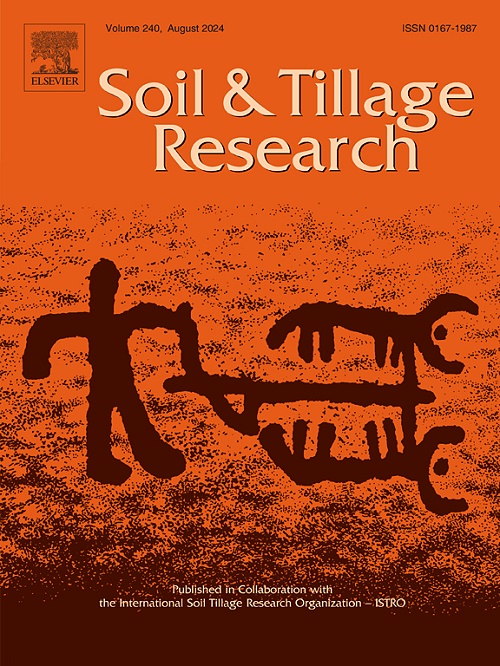Effects of fallow and chemical fertilizer applications on soil carbon and nitrogen pools in North China Plain: Medium-term and long-term trends
IF 6.1
1区 农林科学
Q1 SOIL SCIENCE
引用次数: 0
Abstract
Improving soil fertility is pressingly needed for national and global sustainable development. Land fallow has been considered an important measure to alleviate the degradation of soil fertility. However, it remains unclear regarding how fallow affects soil organic carbon (SOC) and total nitrogen (TN) pools. Therefore, our objective was to assess the effects of fallow on SOC and TN pools along the 0–200 cm soil profile, and to further clarify whether its long-term effects are consistent with medium-term effects. Through a comparative field study on a fluvo-aquic soil, we evaluated both medium (11 years 1991–2001) and long-term (27 years 1991–2016) effects of two land management practices on SOC and TN pools, soil biogeochemical properties and microbial communities. The practices were: (1) natural fallow and (2) chemical N, phosphorus (P) and potassium (K) fertilizers (NPK treatment). Results showed that for the medium-term experiment, SOC and TN pools along the 0–200 cm soil profile in the fallow treatment were 10.9 %-98.9 % and 11.4 %-91.8 %, respectively, of that in NPK. For the long-term experiment, however, the SOC pools in the fallow were 1.1–1.6 times that of NPK, and for TN correspondingly 1.1–1.2 times in the 0–60 cm soil layer but only 16.4 %-75.3 % in the 60–200 cm layer. Furthermore, fallow resulted in lower microbial biomass C (MBC), N mineralization and potential nitrification rate than NPK did. Fallow increased the relative abundance of Proteobacteria but decreased that of Chloroflexi and Nitrospirae. These results imply that the lower microbial activity especially the reduction of nitrification processes may have contributed to the greater soil C and N sequestration of fallow with the time prolonged. In conclusion, medium-term fallow will inhibit the increase of soil C and N storage, although it can improve soil C and N storage in the long term in North China Plain.
华北平原休耕和化肥施用对土壤碳氮库的中长期影响
提高土壤肥力是国家和全球可持续发展的迫切需要。土地休耕一直被认为是缓解土壤肥力退化的重要措施。然而,休耕对土壤有机碳(SOC)和全氮(TN)库的影响尚不清楚。因此,我们的目标是评估休耕对0-200 cm土壤剖面上有机碳和全氮库的影响,并进一步阐明其长期效应是否与中期效应一致。通过对河流-潮土的田间对比研究,我们评估了两种土地管理方式对土壤有机碳和全氮库、土壤生物地球化学性质和微生物群落的中期(1991-2001年11年)和长期(1991-2016年27年)的影响。做法是:(1)自然休耕和(2)化学N、P、K肥(NPK处理)。结果表明,在中期试验中,休耕处理0 ~ 200 cm土壤有机碳和全氮库分别为氮磷钾处理的10.9 % ~ 98.9 %和11.4 % ~ 91.8 %。在长期试验中,休耕期土壤有机碳库是氮磷钾的1.1 ~ 1.6倍,全氮在0 ~ 60 cm土层为1.1 ~ 1.2倍,在60 ~ 200 cm土层仅为16.4 % ~ 75.3 %。与氮磷钾相比,休耕导致微生物量C (MBC)、氮矿化和潜在硝化速率降低。休耕提高了变形菌门的相对丰度,降低了氯氟菌门和硝基螺旋菌门的相对丰度。这些结果表明,随着休耕时间的延长,微生物活性的降低,特别是硝化过程的减少,可能是土壤碳氮固存量增加的原因。综上所述,华北平原中期休耕对土壤碳氮储量的增加有抑制作用,但长期休耕能提高土壤碳氮储量。
本文章由计算机程序翻译,如有差异,请以英文原文为准。
求助全文
约1分钟内获得全文
求助全文
来源期刊

Soil & Tillage Research
农林科学-土壤科学
CiteScore
13.00
自引率
6.20%
发文量
266
审稿时长
5 months
期刊介绍:
Soil & Tillage Research examines the physical, chemical and biological changes in the soil caused by tillage and field traffic. Manuscripts will be considered on aspects of soil science, physics, technology, mechanization and applied engineering for a sustainable balance among productivity, environmental quality and profitability. The following are examples of suitable topics within the scope of the journal of Soil and Tillage Research:
The agricultural and biosystems engineering associated with tillage (including no-tillage, reduced-tillage and direct drilling), irrigation and drainage, crops and crop rotations, fertilization, rehabilitation of mine spoils and processes used to modify soils. Soil change effects on establishment and yield of crops, growth of plants and roots, structure and erosion of soil, cycling of carbon and nutrients, greenhouse gas emissions, leaching, runoff and other processes that affect environmental quality. Characterization or modeling of tillage and field traffic responses, soil, climate, or topographic effects, soil deformation processes, tillage tools, traction devices, energy requirements, economics, surface and subsurface water quality effects, tillage effects on weed, pest and disease control, and their interactions.
 求助内容:
求助内容: 应助结果提醒方式:
应助结果提醒方式:


